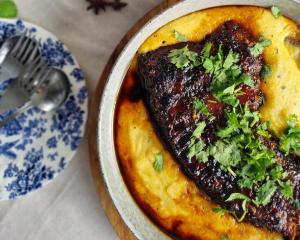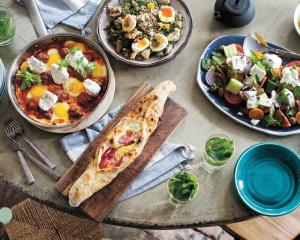
''We want even more people to see the amazing benefits of eating more plants - both in how you feel and in the positive impact it has on the environment,'' they said.
The former digital marketers started out posting videos of their efforts to make tasty plant-based foods on social media - their first video in 2016 got 3.5 million views within a week.
That led to their first cookbook Bosh!, which became the highest-selling vegan cookbook in the United Kingdom.
Their latest book, Bish Bash Bosh, covers all the bases of quick-and-easy dishes along with ''feasts'', sides, greens, desserts and breakfasts.
The pair have no formal training, but describe themselves as ''foodies who once they became vegan found they had to relearn how to cook''.
In the new book there are Italian-inspired dishes (lasagne), curries (dal), Asian classics (satay summer spring rolls), takeaway favourites (katsu), an eat-the-rainbow selection (''broccauliflower'' cheese) and a twist on Sunday roasts (nut roast) and Christmas dinner (Nutella Christmas tree).
They think of themselves as food ''remixers'', taking classic dishes they enjoyed when they ate meat and dairy and making vegan alternatives, all in a simple, easily achievable way.
''Bish'' stands for enjoying favourite meals using only plants - like British comfort food classics bangers with incredible mash or shepherds pie - while ''bash'' is about making the recipes easy to follow with ingredient and prep lists, tips and meal planning ideas.
''Bosh'' is about them creating plant-based meals that fit into everyday lives, are high in fibre and filled with colour and nutrients.
 Photos: Supplied
Curry house jalfrezi
Photos: Supplied
Curry house jalfrezi

The spicy and flavourful jalfrezi has now overtaken tikka masala as Britain's favourite curry. This stock can be prepared in advance and frozen or kept in the fridge in an airtight container, so make a double batch to save time. Be sure to taste the curry as you go to get the perfect balance, as spices can vary in strength.
Serves 3-4
Ingredients
1 large aubergine
4 Tbsp sunflower or olive oil
1 onion
1 red pepper
a small bunch of fresh coriander
5 green bird's-eye chillies
12 cherry tomatoes
3 Tbsp curry powder
1 tsp garam masala
¼-2 tsp hot chilli powder
8 Tbsp tomato puree
500g cooked basmati rice, or use 2 x 250g bags microwaveable basmati rice
For the stock
1 onion
5cm piece fresh ginger
5 garlic cloves
500ml + 1 Tbsp water
½ fresh red chilli
3 cherry tomatoes
1 Tbsp sunflower or olive oil
¼ tsp ground coriander
¼ tsp ground cumin
¼ tsp ground fenugreek
¼ tsp ground turmeric
¼ tsp paprika
Equipment
baking tray
fine grater or microplane
medium saucepan
liquidiser
Method
Heat grill to 200degC.
Trim the aubergine and cut it into 2cm chunks. Spread over the baking tray. Sprinkle with 2 tablespoons oil and a good pinch of salt. Toss to coat. Grill for 15 minutes, turning occasionally. Remove when golden brown all over but not burnt.
While grilling the aubergine, make the stock.
Peel and finely chop the onion. Peel the ginger by scraping off the skin with a spoon and grate. Peel and grate the garlic. Put the ginger and garlic into a bowl and mix with 1 tablespoon water to make a paste.
Finely chop the red chilli and tomatoes. Place the saucepan on a medium heat and pour in the oil. Add the onion and saute for five minutes. Add a teaspoon of the ginger and garlic paste. Add all the remaining spices and half the water and stir.
Simmer for 10 minutes, until browned and reduced completely.
Pour in the rest of the water, stir and transfer to the liquidiser. Blend to a smooth liquid. Clean out the pan.
Back to the curry.
Peel and thinly slice the onion.Cut the pepper in half and cut out the stem and seeds, then thinly slice. Pick the leaves from the coriander.
Finely chop the stems and roughly chop the leaves. Trim and thinly slice two of the chillies. Quarter the tomatoes. Pour the remaining oil into the clean saucepan. Place over a high heat. Add the onion, pepper and sliced chillies and fry for 3 minutes, stirring regularly.
Stir in the chopped coriander stems and remaining ginger and garlic paste (from making the stock). Add the curry powder, garam masala, quarter¼ teaspoon hot chilli powder, tomato puree, grilled aubergines and stock.
Taste and add more salt, garam masala and chilli powder if needed. Stir in the tomatoes.
Simmer gently for 10 minutes, stirring frequently, until slightly thickened.
Heat the rice or cook it following the instructions on the packet.
Transfer to a serving dish. Cut the remaining chillies in half lengthways and use them to garnish the curry along with the chopped coriander leaves.
Serve with the rice.
 Mini banoffee meringues
Mini banoffee meringues

It's a joyous and magical experience to watch a drizzle of chickpea water turn into a fluffy, sweet meringue mix!
Ideally, use a stand mixer with a whisk attachment for this recipe as in our experience hand-whisks don't have the power to get the chickpea water into stiff peaks.
Makes 18
Ingredients
140ml aquafaba (the drained water from
1 400g tin chickpeas)
½ tsp cream of tartar
100g caster sugar
2-3 bananas
25g dark chocolate
For the caramel sauce
150g caster sugar
120ml full-fat coconut milk
a pinch of salt
½ tsp dairy-free butter
For the cashew cream
150g cashews
600ml full-fat coconut milk
2 Tbsp icing sugar
1 tsp vanilla extract
½ banana
Equipment
stand mixer
line 3 baking sheets with parchment paper
frying pan
small saucepan
liquidiser
Method
Heat oven to 180degC.
Pour the aquafaba into the mixer. Turn the mixer on to high and leave it running. Add the cream of tartar and continue to beat.
After 2 minutes, add the caster sugar, one spoonful at a time. Beat on high for 10-15 minutes. It's ready when the aquafaba has magically transformed into a thick, meringue-like mixture that won't fall off a spoon turned upside down.
Spoon the meringue mixture on to the lined baking sheets to make nests about 8cm wide, no more than 1.5cm high and smooth on top, leaving 2cm between them.
You should end up with about 18 nests (you can draw 8cm circles on the parchment paper, then flip over the paper and use them as templates.
Put the trays in the oven and immediately reduce the heat to 100degC. Bake for 2 hours, then turn off the heat, leave the door closed and let the meringues cool completely, preferably overnight.
Cooling the meringues overnight in the oven allows them to set properly and reduces the chances of them cracking due to sudden changes in temperature.
To make the caramel sauce, put the frying pan on a medium heat. Pour in the sugar, 75ml of the coconut milk and the salt. Bring to the boil, whisking continuously.
Once the mixture has turned caramel in colour, about 10-15 minutes, remove from the heat. Add the rest of the coconut milk and the dairy-free butter, stir through and transfer to a heatproof bowl.
To make the cashew cream, put the small saucepan over a medium heat. Add the nuts and 400ml of the coconut milk. Bring to the boil, then reduce the heat and simmer until most of the coconut milk has evaporated.Transfer to the liquidiser. Add the icing sugar, vanilla and remaining 200ml coconut milk. Add the banana half to the liquidiser. Blend until really smooth.
Place your meringue nests on serving plates.
Peel 2-3 bananas and cut them into long diagonal slices (the longer they are the more beautiful they will look). Lay half the slices on top of the meringues.
Cover the bananas with dollops of coconut cream. Top with 1 or 2 more banana slices and lashings of caramel sauce.
Finely grate over the chocolate and serve.
 Faux gras
Faux gras

This amazing recipe was the brainchild of Alexis Gauthier, and was shared with the world through a collaboration we did with him.
Spread it on sourdough toast and serve with cornichons for the perfect starter or canape with drinks - it tastes like proper, posh pate! If you're eating it straight away, serve in ramekins, or else store in sterilised jars in the fridge for up to a week.
Makes 4 small jars or ramekins
Ingredients
2 sprigs fresh rosemary
3 sprigs fresh thyme
7 sage leaves
2 Tbsp olive oil
1 eschalion (banana) shallot
a pinch of salt
2 garlic cloves
18 button mushrooms
2 Tbsp cognac
150g walnuts
½ or 1 very small cooked beetroot (about 30g)
400g cooked lentils (home-made or from a packet)
2½ Tbsp soy sauce
100g dairy-free butter
a few peppercorns, to garnish
good-quality toasted sourdough bread or baguette (or a pack of crackers),
to serve
cornichons, to serve
Equipment
optional 4 small sterilised glass jars or ramekins
frying pan
food processor
small saucepan
Method
Pour the oil into the frying pan over a medium heat. Peel and roughly chop the shallot and add it to the pan. Add a pinch of salt and cook for about seven minutes, stirring occasionally, until translucent.
Peel and roughly chop the garlic and add to the pan. Cook for a further three minutes. Chop the mushrooms and add them to the pan. Cook, stirring continuously, for five minutes, until everything is well softened.
Add the finely chopped herbs and the cognac. Transfer the contents of the pan to the food processor. Chop the walnuts and add them to the processor with the cooked lentils, soy sauce and beetroot. Blitz until almost smooth.
Transfer the mixture to the prepared jars or ramekins and smooth the tops with the back of a spoon. Place the small saucepan over a low heat.
Add the dairy-free butter and melt without heating it too much as it can split. Pour it over the pate to completely cover. Place a few herb leaves, sprigs and peppercorns on top and leave to cool.
Seal the jars (or cover the ramekins with cling wrap) and refrigerate to chill.
Serve with the toasted sour dough bread or crackers and cornichons,if using.
Tips: To sterilise the jars and lids, wash them in hot, soapy water then fill them to the top with boiling water. Drain on a tea towel until completely dry. Remove the leaves from the herbs by running your thumb and forefinger from the top to the base of the stems (the leaves should easily come away). Reserve a few leaves and sprigs for garnish and finely chop the rest.













